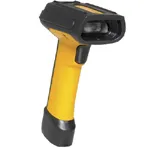Customers new to barcoding typically ask, "What is a barcode scanner?"
The answer is simple: A
barcode scanner—also known as a barcode reader—is an electronic device that decodes and physically captures information contained in
barcodes. It consists of the following components, which work together to collect the data contained in a printed barcode:
- Light source – Illuminates the barcode for proper reading.
- Lens – Scans the barcode image.
- Photo conductor – Translates optical impulses into electrical ones.
- Decoder – Analyzes the data and sends the content to the scanner’s output port. A decoder can be internal or external.
After capturing an image, barcode scanners link to a host computer to pass along the scanned information. This automates the data collection process so organizations can reduce human error and expedite tasks such as tracking inventory, managing assets, and monitoring point-of-sale transactions.
Barcode scan engines

Datalogic's PowerScan® 7000 is a high-performing 2D barcode scanner that is perfect for industrial environments where durability is important. This is only one of the many barcode scanners sold by System ID.
There are three primary barcode scan engines, which decode or read a barcode:
Learn more about barcode scan engines.
Barcode scanner types
Sometimes referred to as form factors, barcode scanners are categorized in the following types, which have features unique to specific environments, applications, and industries:
- Handheld – The most popular type of barcode scanner. Comes in both corded and cordless (wireless) models.
- Mobile computers – Combines functionality of a PC and a barcode scanner into one device. Sometimes confused with cordless barcode scanners.
- Presentation - A type of hands-free scanner that allows users to easily scan multiple items. Also known as an on-counter or multi-plane scanner.
- In-counter - Similar to a multi-plane presentation scanner except that it sits inside a counter instead of on top of it.
- Fixed-mount – Another type of hands-free scanner that reads barcodes using sensors that are triggered when items pass in front of it.
- Wearable – Includes scanners typically worn on the arm, hand, or finger.
Learn more about barcode scanner types.
RFID
In addition to barcodes, organizations use radio-frequency identification (RFID) technology to electronically capture information about an object, such as assets or inventory.
RFID readers (interrogators) use two-way radio transmitter-receivers to automatically track and identify objects that have RFID tags attached to or embedded in them. Usually readers are fixed, which means that they stay in one spot. This allows organizations to tightly control the reading area. However, there are also handheld or mounted readers that enable mobile scanning.
There are two types of RFID tags (labels):
- Active – Contains an onboard battery that periodically transmits an ID signal.
- Passive – Doesn’t contain a battery, which makes them cheaper.
Learn more about RFID.
